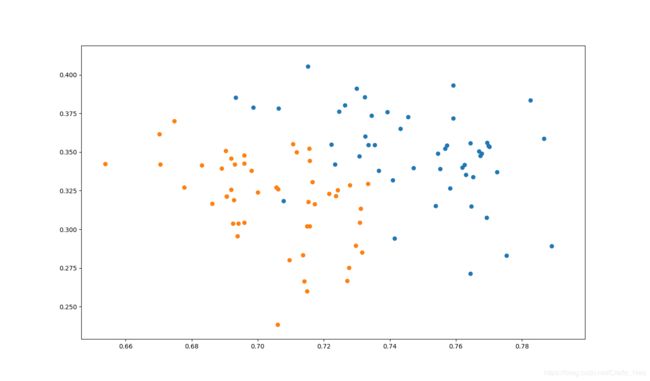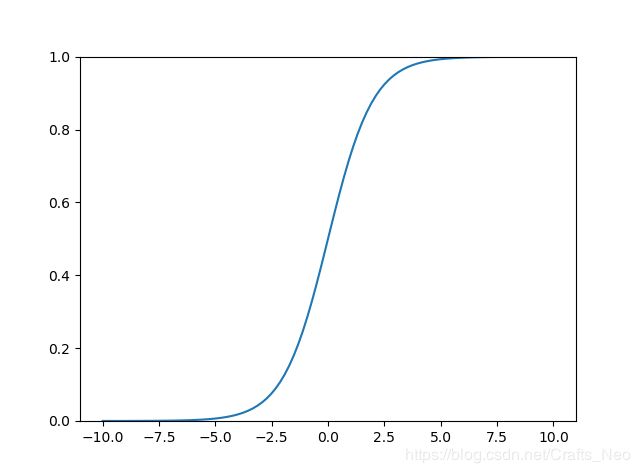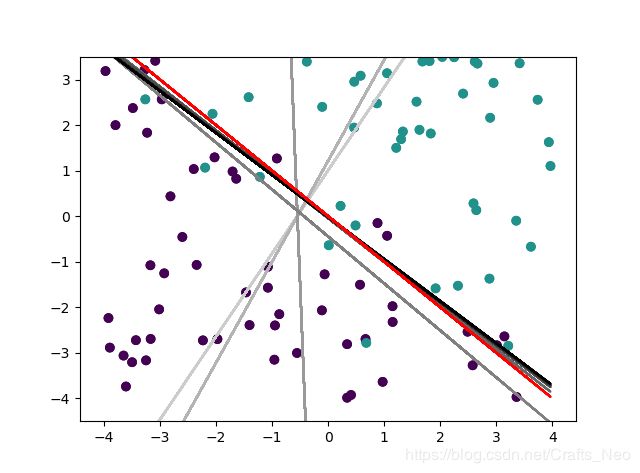李宏毅机器学习 Machine_Learning_2019_Task 6
李宏毅机器学习 Machine_Learning_2019_Task 6
学习要求
- 公式手动推导
- 不掉包,手动实现算法
- 独立手动创建数据,实现分类任务
- 学习算法内容,对数据进行归一化操作
- 主要是学习LR算法的核心代码
学习内容
- 李航机器学习
- 机器学习实战
- 负责人笔记
方案 1 (参考负责人笔记)
import numpy as np
import matplotlib.pyplot as plt
# 封装 LR 为一个类
class Logistic_Regression(object):
def __init__(self, learning_rate=0.1, max_iter=100, seed=None):
self.seed = seed
self.lr = learning_rate
self.max_iter = max_iter
def fit(self, x, y):
np.random.seed(self.seed)
self.w = np.random.normal(loc=0.0, scale=1.0, size=x.shape[1])
self.b = np.random.normal(loc=0.0, scale=1.0)
self.x = x
self.y = y
for i in range(self.max_iter):
self._update_step()
def _sigmoid(self, z):
return 1.0 / (1.0 + np.exp(-z))
def _f(self, x, w, b):
z = x.dot(w) + b
return self._sigmoid(z)
def predict_proba(self, x=None):
if x is None:
x = self.x
y_pred = self._f(x, self.w, self.b)
return y_pred
def predict(self, x=None):
if x is None:
x = self.x
y_pred_proba = self._f(x, self.w, self.b)
y_pred = np.array([0 if y_pred_proba[i] < 0.5 else 1 for i in range(len(y_pred_proba))])
return y_pred
# 定义 精度
def score(self, y_true=None, y_pred=None):
if y_true is None or y_pred is None:
y_true = self.y
y_pred = self.predict()
acc = np.mean([1 if y_true[i] == y_pred[i] else 0 for i in range(len(y_true))])
return acc
# 定义损失函数
def loss(self, y_true=None, y_pred_proba=None):
if y_true is None or y_pred_proba is None:
y_true = self.y
y_pred_proba = self.predict_proba()
return np.mean(-1.0 * (y_true * np.log(y_pred_proba) + (1.0 - y_true) * np.log(1.0 - y_pred_proba)))
# 计算梯度
def _calc_gradient(self):
y_pred = self.predict()
d_w = (y_pred - self.y).dot(self.x) / len(self.y)
d_b = np.mean(y_pred - self.y)
return d_w, d_b
# 更新模型参数
def _update_step(self):
d_w, d_b = self._calc_gradient()
self.w = self.w - self.lr * d_w
self.b = self.b - self.lr * d_b
return self.w, self.b
# 随机生成训练数据
def generate_data(seed):
np.random.seed(seed)
data_size_1 = 400
x1_1 = np.random.normal(loc=5.0, scale=1.0, size=data_size_1)
x2_1 = np.random.normal(loc=4.0, scale=1.0, size=data_size_1)
y_1 = [0 for _ in range(data_size_1)]
data_size_2 = 400
x1_2 = np.random.normal(loc=10.0, scale=2.0, size=data_size_2)
x2_2 = np.random.normal(loc=8.0, scale=2.0, size=data_size_2)
y_2 = [1 for _ in range(data_size_2)]
x1 = np.concatenate((x1_1, x1_2), axis=0)
x2 = np.concatenate((x2_1, x2_2), axis=0)
x = np.hstack((x1.reshape(-1, 1), x2.reshape(-1, 1)))
y = np.concatenate((y_1, y_2), axis=0)
data_size_all = data_size_1 + data_size_2
shuffled_index = np.random.permutation(data_size_all)
x = x[shuffled_index]
y = y[shuffled_index]
return x, y
# 划分训练集和测试集
def train_test_split(x, y):
split_index = int(len(y) * 0.7)
x_train = x[:split_index]
y_train = y[:split_index]
x_test = x[split_index:]
y_test = y[split_index:]
return x_train, y_train, x_test, y_test
x, y = generate_data(seed=272)
x_train, y_train, x_test, y_test = train_test_split(x, y)
# 数据归一化
x_train = (x_train - np.min(x_train, axis=0)) / \
(np.max(x_train, axis=0) - np.min(x_train, axis=0))
x_test = (x_test - np.min(x_test, axis=0)) / \
(np.max(x_test, axis=0) - np.min(x_test, axis=0))
# 创建分类器
clf = Logistic_Regression(learning_rate=0.1, max_iter=500, seed=272)
clf.fit(x_train, y_train)
# 结果可视化
split_boundary_func = lambda x: (-clf.b - clf.w[0] * x) / clf.w[1]
xx = np.arange(0.1, 0.6, 0.1)
cValue = ['g', 'b']
plt.scatter(x_train[:, 0], x_train[:, 1], c=[cValue[i] for i in y_train], marker='o')
plt.plot(xx, split_boundary_func(xx), c='red')
plt.show()
# 结果预测、输出精度和损失
y_test_pred = clf.predict(x_test)
y_test_pred_proba = clf.predict_proba(x_test)
print(clf.score(y_test, y_test_pred))
print(clf.loss(y_test, y_test_pred_proba))
方案 2
'''
独立手动创建数据,实现分类任务
'''
import numpy as np
import matplotlib.pyplot as plt
def generate_data(seed):
np.random.seed(seed)
data_size_1 = 400 # 类别 1
x1_1 = np.random.normal(loc=5.0, scale=1.0, size=data_size_1) # 特征 1
# print(x1_1)
x1_2 = np.random.normal(loc=4.0, scale=1.0, size=data_size_1) # 特征 2
y_1 = [0 for i in range(data_size_1)]
# print(y_1)
data_size_2= 400 # 类别 1
x2_1 = np.random.normal(loc=10.0, scale=2.0, size=data_size_2) # 特征 1
x2_2 = np.random.normal(loc=8.0, scale=2.0, size=data_size_2) # 特征 2
y_2 = [1 for i in range(data_size_2)]
x1 = np.concatenate((x1_1, x1_2), axis=0)
print(x1.shape) # (800,)
x2 = np.concatenate((x2_1, x2_2), axis=0)
print(x2.shape) # (800,)
# 合成新的数据集 从水平方向拼接
x = np.hstack((x1.reshape(-1, 1), x2.reshape(-1, 1)))
# x = normalize(x)
print(x.shape)
# 通过指定axis进行选择拼接方向
y = np.concatenate((y_1, y_2), axis=0)
print(y.shape)
# 总数据
data_size_all = data_size_1 + data_size_2
# 随机打乱数据
shuf_data = np.random.permutation(data_size_all)
x = x[shuf_data]
y = y[shuf_data]
print(type(x)) # 方案 3 (利用 Scikit-Learn 的数据集)
from __future__ import print_function, division
import matplotlib.pyplot as plt
from sklearn import datasets
import numpy as np
import math
'''
独立手动创建数据,实现分类任务
'''
def shuffle_data(X, y, seed=None):
if seed:
np.random.seed(seed)
idx = np.arange(X.shape[0])
np.random.shuffle(idx)
return X[idx], y[idx]
# 正规化数据集 X
def normalize(X, axis=-1, p=2):
lp_norm = np.atleast_1d(np.linalg.norm(X, p, axis))
lp_norm[lp_norm == 0] = 1
return X / np.expand_dims(lp_norm, axis)
# 标准化数据集 X
def standardize(X):
X_std = np.zeros(X.shape)
mean = X.mean(axis=0)
std = X.std(axis=0)
# 做除法运算时请永远记住分母不能等于0的情形
# X_std = (X - X.mean(axis=0)) / X.std(axis=0)
for col in range(np.shape(X)[1]):
if std[col]:
X_std[:, col] = (X_std[:, col] - mean[col]) / std[col]
return X_std
# 划分数据集为训练集和测试集
def train_test_split(X, y, test_size=0.2, shuffle=True, seed=None):
if shuffle:
X, y = shuffle_data(X, y, seed)
n_train_samples = int(X.shape[0] * (1-test_size))
x_train, x_test = X[:n_train_samples], X[n_train_samples:]
y_train, y_test = y[:n_train_samples], y[n_train_samples:]
return x_train, x_test, y_train, y_test
# 将一个向量转换成对角阵,其中对角阵上的元素就是向量中元素
def vec2diagonal(vec):
vec_length = len(vec)
diagonal = np.zeros((vec_length, vec_length))
for i in range(vec_length):
diagonal[i][i] = vec[i]
return diagonal
def accuracy(y, y_pred):
y = y.reshape(y.shape[0], -1)
y_pred = y_pred.reshape(y_pred.shape[0], -1)
return np.sum(y == y_pred)/len(y)
class Sigmoid:
def function(self, x):
return 1/(1 + np.exp(-x))
def derivative(self, x):
return self.function(x) * (1 - self.function(x))
class LogisticRegression():
"""
手写逻辑回归算法
learning_rate 学习率
Sigmoid 激活函数
"""
def __init__(self, learning_rate=.1):
self.w = None
self.learning_rate = learning_rate
self.sigmoid = Sigmoid()
def fit(self, X, y, n_iterations=4000):
# 在第一列添加偏置列,全部初始化为 1
X = np.insert(X, 0, 1, axis=1)
X = X.reshape(X.shape[0], -1)
y = y.reshape(y.shape[0], -1)
n_samples, n_features = np.shape(X)
# 参数初始化 [-1/n_features, 1/n_features]
limit = 1 / math.sqrt(n_features)
self.w = np.random.uniform(-limit, limit, (n_features, 1))
for i in range(n_iterations):
# 通过初始化的参数 w 计算预测值
y_pred = self.sigmoid.function(X.dot(self.w))
# 梯度下降更新参数w.
self.w -= self.learning_rate * \
X.T.dot(-(y - y_pred) * \
self.sigmoid.function(X.dot(self.w)) * \
(1 - self.sigmoid.function(X.dot(self.w))))
def predict(self, X):
# 训练模型时添加偏置,预测的时候也需要添加偏置
X = X.reshape(X.shape[0], -1)
X = np.insert(X, 0, 1, axis=1)
# 预测
y_pred = np.round(self.sigmoid.function(X.dot(self.w))).astype(int)
return y_pred
def main():
# 加载数据集
data = datasets.load_iris()
X = normalize(data.data[data.target != 0])
y = data.target[data.target != 0]
y[y == 1] = 0
y[y == 2] = 1
X_train, X_test, y_train, y_test = train_test_split(X, y, test_size=0.33, seed=1)
clf = LogisticRegression()
clf.fit(X_train, y_train)
y_pred = clf.predict(X_test)
accu = accuracy(y_test, y_pred)
print ("Accuracy:", accu) # Accuracy: 0.9393939393939394
plt.figure(figsize=(12, 8))
plt.scatter(X[y==0][:,0], X[y==0][:,1])
plt.scatter(X[y==1][:,0], X[y==1][:,1])
plt.show()
if __name__ == "__main__":
main()
方案 4
'''
实现两个特征变量的LR算法的线性分类器(二分类问题)
'''
# 导入所需的包
import numpy as np
import matplotlib.pyplot as plt
# 生成模拟数据
z = np.linspace(-10, 10, 100)
sigm = 1./(1. + np.exp(-z))
result_plot = plt.plot(z, sigm)
result_visual = plt.ylim(0, 1)
plt.show()
# 加入随机噪声进一步得到模拟数据
np.random.seed(20190601)
m = 100 # 样本量
xlim = 4 # 数据采样范围
x0 = np.ones((m, 1))
x1 = np.random.rand(m, 1)*xlim*2 - xlim
x2 = np.random.rand(m, 1)*xlim*2 - xlim
y_ = 1./(1. + np.exp(-(x1 + x2))) + np.random.randn(m, 1)*0.2
y = np.round(y_)
# 作图可视化
_ = plt.scatter(x1, x2, c=y)
_ = plt.plot(x1, -x1, 'r')
_ = plt.ylim(-4.5, 3.5)
plt.show()
# 假设函数
def h_theta(X, theta):
return 1. / (1. + np.exp(- np.dot(X, theta)))
# 损失函数
def loss_func(X, theta, y):
y1 = np.log(h_theta(X, theta))
y0 = np.log(1. - h_theta(X, theta))
return -1. / m * (np.dot(y.T, y1) + np.dot((1. - y.T), y0))
# 梯度函数
def grad_func(X, theta, y):
return 1. / m * np.dot(X.T, h_theta(X, theta) - y)
# 生成随机种子
np.random.seed(20190601)
# 设置学习率和收敛阈值
alpha = 0.1
stop = 1e-6
i = 1
index = 1
c = np.array([0.8, 0.8, 0.8]) # 设置颜色,颜色逐渐加深
theta = np.random.randn(3, 1)
X = np.hstack((x0, x1, x2))
grad = grad_func(X, theta, y)
while not np.all(abs(grad) <= stop):
theta = theta - alpha * grad
grad = grad_func(X, theta, y)
# 作出学习过程
i = i + 1
if i % index == 0:
yline = -theta[0] / theta[2] - theta[1] / theta[2] * x1
_ = plt.plot(x1, yline, color=c)
c = c - 0.1
index = index * 4
res_scat = plt.scatter(x1, x2, c=y)
res_plt = plt.plot(x1, -x1, 'r')
res_visual = plt.ylim(-4.5, 3.5)
plt.show()
# 测试数据
np.random.seed(2019060134) #修改随机种子
test_x0 = np.ones((m, 1))
test_x1 = np.random.rand(m, 1)*xlim*2 - xlim
test_x2 = np.random.rand(m, 1)*xlim*2 - xlim
test_ty = 1./(1. + np.exp(-(test_x1 + test_x2))) + np.random.randn(m, 1)*0.2
test_y = np.round(test_ty)
test_X = np.hstack((test_x0, test_x1, test_x2))
y_ = h_theta(test_X, theta)
pre_y = np.round(y_)
acc = sum(int(a == b) for a, b in zip(pre_y, test_y))/m
print(acc) # 0.91
Next Step Plan
熵
- 证明
- 计算信息熵(Machine Learning in Action P36)
- 学习联合概率和边缘概率
- 推导条件熵公式
- 学习相对熵以及互信息
- 理解交叉熵为什么能做为 Loss Function
决策树
- 李航统计学习 P55-P58
- 总结决策树模型结构
- 理解决策树递归思想
- 学习信息增益以及信息增益率
- 学习ID3、C4.5算法的优缺点
- 理解C4.5在ID3上有何提升
- 学习C4.5在连续值上的处理
- 学习决策树的生成过程
- Machine Learning in Action
- 手写划分数据集代码
- 手动实现选择最好的数据集划分方式
- 手动实现创建树的函数
- 根据提供的数据创建树的图形
CART分类回归树
- 李航统计学习 P65-67
- 学习预剪枝
- 学习后剪枝
- 学习基尼系数
- 学习CART的生成(回归树模型)
面试之灵魂拷问
算法十问



